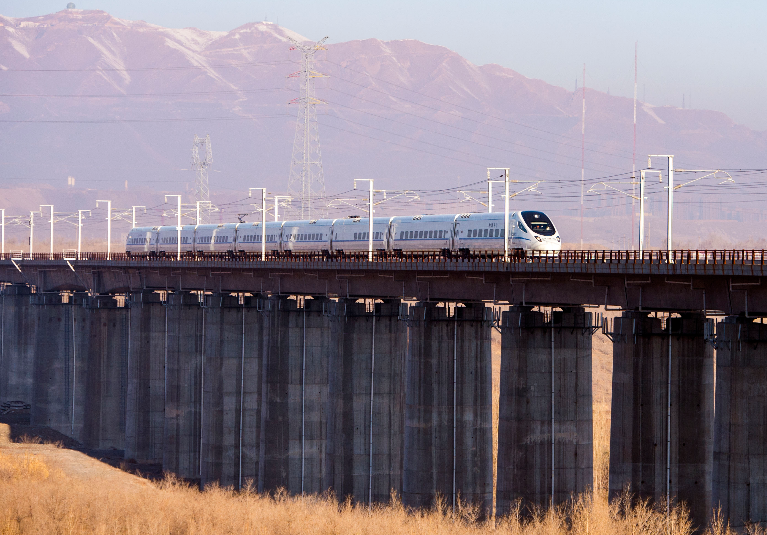-- Silk Road Economic Belt
The proposed economic belt is considered the longest economic corridor in the world -- and potentially the most dynamic -- connecting the Asia-Pacific region in the east with developed European economies in the west.
-- Silk Road Routes
Generally speaking, the Silk Road is divided into 3 parts: Xi'an to Dunhuang, Taklimakan Desert to Kashgar, beyond Kashigar.
The Silk Road starts from Changan (nowadays Xi'an), passes westwards via Lanzhou, Hexi Corridor, and splits at Dunhuang from south and north of Taklimakan Desert.
The south road goes successively through Dunhuang, Hami, Turfan, Korla, Kuche, Kashgar, and north road passes through Dunhuang, Cherchen, Khotan, Yarkand, Kashgar. Then they rejoin together at Kashgar where still is within the territory of China.
After Kashgar, the main route goes across the Pamirs into Central Asia, which is also splited into two routes of south and north. Historically we named it Irkeshtam Pass and the Torugart Pass. The former goes across Pmirs and Ferghana velley, keeps going in Uzbekistan through Kokand, Tashkent, Samarkand and Bukhara, gets into Turkmenistan and arrives at Mashhad of Iran. The Silk Road seperates again here into South road and north road.
The south road goes through three countries-Iraq, Syria and Egypt. The final stop in Alexandra City in Egypt. The north road go straight to Istanbul of Turkey.
-- The Significance of the Silk Road
The silk road played an important role in history. Whether to aspects of history, economic, culture or tourism, the silk road has an indelible significance. As an important material exchange channel, the silk road primitively connected the goods circulation between the east and the west of the world and later was branded as a "cultural exchange" and played a considerable role in cultural exchange.

Photo: The CRH train D8602 runs to Hami from Urumqi, capital of northwest China's Xinjiang Uygur Autonomous Region, Nov. 16, 2014. (Xinhua/Jiang Wenyao)
Historical significance of Silk Road
The silk road is a symbol of the Chinese nation's going to the world, and it is related to the rise and fall of the Chinese nation. In ancient times, under the circumstance that the communication between east and west countries was so inconvenient, the Silk Road created a platform helping the exchange of Chinese and western countries.
The opening of the silk road effectively promoted the economic and cultural exchanges between the east and the west, especially played a positive role in promoting the prosperity of the Han dynasty. The silk road, which is still an important path for Chinese and western exchanges, completed its mission at the time of industrialization. It has been replaced by the 10900-kilometer new Eurasian Land Bridge, but it still has new value to be developed.
Economic significance of Silk Road
The silk road was a famous land trade route that traversed Asia and connected Eurasia in ancient times. It expanded China's foreign economic trade and made the world know China. At the same time, it promoted the trade between China and other countries in the world, and achieved mutual benefit and reciprocity, laying a good foundation for future cooperation. In addition, silk also brought about the progress of the world.
Cultural significance of Silk Road
Trading activities along the Silk Road over many centuries facilitated the transmission not just of goods but also ideas and culture, notably in the area of religions, Buddhism and art.
The spread of religions and cultural traditions along the Silk Roads also led to syncretism. One example was the encounter with the Chinese and Xiongnu nomads. The Xiongnu adopted Chinese agricultural techniques, dress style, and lifestyle, while the Chinese adopted Xiongnu’s military techniques, some dress style, music, and dance.
The Silk Road enormously promoted the culture exchanges between China and western countries. Also, it helped established the great influence of Chinese culture and Chinese history in the world, especially the Han Dynasty culture.
Tourism significance of Silk Road
Silk Road likes a bet to link many mysterious cultures together. For tourists who are interested in history of China, going to the Silk Road can find about the footprint of the ancient merchants. For tourists who are interested in ethnic experience, a trip to the Silk Road can get close touch with the hospitable Uygur people. For tourists who are interested in the scenery of gobi, desert, oasis, and Yadan landform, go to the Silk Road and you will take fantastic photos and catch the breathless scene in your mind for your whole life.
-- Silk Road Economic Belt
In 2013, China proposed building a Silk Road Economic Belt to expand Eurasian economic cooperation. An innovative cooperative approach was outlined, starting with individual projects that are expected to help spur larger-scale regional cooperative development. The proposed economic belt is considered the longest economic corridor in the world – and potentially the most dynamic – connecting the Asia-Pacific region in the east with developed European economies in the west.




 A single purchase
A single purchase









